Do you have a question about the Komatsu PC12R-8 and is the answer not in the manual?
Defines the intended applications and authorized optional equipment for the machines.
Details forbidden uses and potential hazards of misuse.
Lists the key features and design aspects of the machines.
Provides instructions for the initial break-in period to ensure proper machine performance.
Explains where to find the unique serial number for identification and service.
Details the information found on the machine's identification plate, including CE mark.
Locates serial numbers and emission plates for the engine.
Identifies the location of the serial number for the travel reduction gear.
Specifies the location of the serial number for the swing reduction gear.
Indicates where the serial number for the cab is stamped.
Explains the purpose and location of safety, noise, and vibration plates on the machine.
Illustrates the locations of safety plates on the machine for easy identification.
Explains the meaning of various pictograms and warning symbols used on the machine.
Shows where noise level plates are located on machines equipped with a cab.
Shows where noise level plates are located on machines equipped with a canopy.
Essential general safety rules, devices, guards, and personal protective items.
Fundamental rules for safe operation and maintenance.
Importance of using and maintaining safety devices and guards for accident prevention.
Guidelines on appropriate clothing and PPE for safe operation and maintenance.
Safety measures to avoid burns from hot engine parts, fluids, or steam.
Importance of locating and checking fire extinguishers and first aid kits.
Guidelines for installing and using optional equipment safely and correctly.
Essential safety checks and considerations for the work area before starting operations.
Measures to prevent fires by removing flammable materials and checking fluid systems.
Ensuring the operator's cab is clean, organized, and safe for operation.
Importance of proper ventilation, especially in confined spaces, to avoid gas hazards.
Steps and safety checks for starting the engine before operating the machine.
Verifying the blade position to ensure correct travel control operation.
Safety measures and checks required when operating the machine in reverse.
Guidelines for safe machine movement, including bucket position and speed.
Specific precautions and techniques for safely moving the machine on slopes.
Safe practices for operating the machine on slopes, including rotation and soil accumulation.
Critical safety measures and minimum distances to avoid electrocution from overhead power lines.
Procedures for safely parking the machine on level ground and slopes.
Detailed steps and safety precautions for loading and unloading the machine onto vehicles.
Considerations for safe transport, including route planning and regulatory compliance.
Hazards associated with batteries (acid, hydrogen) and necessary precautions.
Correct and safe procedure for starting the engine using booster cables.
Safety measures and procedures for removing the machine.
Importance of using and placing warning plates during maintenance to prevent accidental startup.
Guidelines for selecting and using appropriate tools for maintenance tasks.
Safety measures when working underneath the machine, ensuring it is properly supported.
Proper methods for cleaning the machine, avoiding high-pressure water on sensitive parts.
Mandatory procedure to stop the engine and secure the machine before any maintenance.
Safety guidelines for refueling and topping up fluids, preventing spills and fires.
Critical safety steps when dealing with high-pressure oil, including PPE and leak checks.
Details the various locking mechanisms (anti-rotation, boom swing, equipment controls) for securing the machine.
Diagram and labels identifying major components visible from the front of the machine.
Diagram and labels identifying components for machines equipped with a canopy.
Labeled diagram of the driver's seat area, identifying controls and instruments.
Explanation of the hour meter and fuel level indicator.
Identifies and explains the function of various warning lights on the dashboard.
Identifies and explains the function of various switches and push buttons.
Comprehensive guide to all machine control levers, pedals, and their functions.
Detailed explanation of basic and combined maneuvers for equipment control levers.
Instructions for operating travel and steering control levers for forward/reverse movement.
Procedure for operating the boom swing control pedal for left/right movement.
Operation of the left safety device lever to lock machine movements.
Operation of the right safety device lever to lock machine movements.
How to use the pedal to increase machine travel speed.
Control of optional equipment using a dedicated pedal.
Procedure for locking and unlocking the upper structure rotation.
Table detailing fuse positions, colors, capacities, and circuits.
Table listing relay positions and their functions.
Safety precautions and procedures for opening and closing the engine hood.
Safety information regarding the ROPS/FOPS certified canopy.
Safety information regarding the ROPS/FOPS certified cab and its features.
Instructions for operating the sliding cab door safely, including locking mechanisms.
Procedures for safely opening and closing the front windshield, including wiper connector.
Explanation of the cab's ventilation and heating system for operator comfort.
Importance of using and maintaining the safety belt for operator protection.
Location and use of the emergency exit hammer and window.
Requirements for installing and checking the fire extinguisher.
Critical pre-operation checks including visual and daily inspections.
Detailed list of visual checks to perform before starting the engine.
Essential daily checks before starting operations, including fluid levels.
Procedures for starting the engine under various climate conditions.
Procedure for starting the engine under normal temperature conditions.
Specific procedure for starting the engine in cold weather conditions, including preheating.
General instructions and safety precautions for moving the machine.
Detailed instructions and diagrams for changing direction and performing counter-rotations.
Specific precautions and techniques for safely moving the machine on slopes.
Steps and safety measures for parking the machine on level ground.
Critical safety procedures for parking the machine on slopes.
Safe procedure for stopping the engine, including warm-down recommendations.
Detailed steps and safety precautions for loading and unloading the machine onto vehicles.
Procedures and safety for lifting the machine using designated points.
Specific lifting points and procedures for machines equipped with a cab.
Recommendations for fuel and oil types suitable for cold weather operation.
Antifreeze usage and safety precautions related to coolant in cold conditions.
Battery precautions in cold weather, including capacity and explosion risks.
End-of-work precautions for cold weather to prevent freezing and damage.
Seasonal checks and preparations for warm weather operation.
Steps to prepare the work area for efficient and safe operation of the work equipment.
How to position the machine correctly for digging, including slope and visibility considerations.
Correct techniques and safety advice for effective digging operations.
Step-by-step guide for safely changing the bucket attachment.
Procedure for adjusting the track gauge for maneuverability and stability.
How to adjust the blade for different track gauge configurations.
Comprehensive storage preparation steps to protect the machine during inactivity.
Steps to take to prepare the machine for use after a long period of inactivity.
Describes normal machine behaviors that are not indicative of malfunctions.
Procedures for safely removing the machine if it gets stuck or breaks down.
Safety precautions and procedures for dealing with a discharged battery.
Detailed instructions for safely starting the engine with booster cables.
Troubleshooting common issues in electrical, hydraulic, and engine systems.
Common electrical issues, their causes, and recommended remedies.
Common hydraulic system problems, their causes, and solutions.
Common engine issues, their causes, and recommended remedies.
General guidelines and procedures for performing maintenance on the machine.
Important notes regarding engine oil and coolant maintenance.
Selection and maintenance operations for engine oil.
Coolant function, level checks, and safety precautions.
Procedures and precautions for hydraulic system maintenance, including oil and filter changes.
List of wear parts, their codes, and recommended replacement intervals.
Guidelines for selecting and using fuel, coolant, and lubricants.
Table specifying fluids and lubricants based on ambient temperature.
Table detailing lubrication points, consistency, and type of grease.
List of authorized HEES synthetic biodegradable hydraulic oils.
Table of standard driving torques for various screw sizes and grades.
Diagram showing lubrication points and intervals for PC12R.
Diagram showing lubrication points and intervals for PC12R HS.
Diagram showing lubrication points and intervals for PC15R.
Diagram showing lubrication points and intervals for PC15R HS.
Lists critical safety components in the fuel supply system that require periodic replacement.
Lists critical safety hydraulic pipes for PC12R/PC12R HS requiring periodic change.
Lists critical safety hydraulic pipes for PC15R/PC15R HS requiring periodic change.
Identifies the safety belt as a critical part for operator safety needing periodic replacement.
Maintenance tasks that should be performed as needed, with corresponding page references.
Procedure for washing the cooling circuit to remove deposits.
Procedure for checking and adjusting the tension of steel tracks.
Criteria and procedure for checking rubber track wear and damage.
Procedure for checking and adjusting the tension of rubber tracks.
Step-by-step guide for safely removing and installing rubber tracks.
Specific maintenance intervals for machines equipped with a demolition hammer.
Procedure for changing the hydraulic oil filter, with interval chart.
Routine checks to be performed before starting the engine.
General pre-start checks covering screws, leaks, equipment wear, and safety items.
Procedure for checking the coolant level in the compensation tank.
Procedure for checking hydraulic oil level, including conditions and precautions.
Maintenance tasks to be performed every 250 hours.
Procedure for changing the hydraulic system oil filter.
Procedure for changing the engine oil, including draining and refilling.
Maintenance tasks to be performed every 500 hours.
Procedure for changing the fuel filter and bleeding the circuit.
Procedure for changing the fuel pump precleaner and bleeding the circuit.
Procedure for changing the air cleaner cartridge.
Maintenance tasks to be performed every 2000 hours.
Procedure for changing hydraulic oil and cleaning the suction filter.
Procedure for changing the coolant, including circuit flushing.
Detailed technical data and specifications for the machine models.
Drawings showing overall dimensions for PC12R with cab and canopy.
Key technical specifications for the PC12R model, including mass, engine, and electrical system.
Drawings showing overall dimensions for PC12R HS with cab and canopy.
Key technical specifications for the PC12R HS model.
Drawings showing overall dimensions for PC15R with cab and canopy.
Key technical specifications for the PC15R model.
Lifting capacity data for PC12R with raised blade, showing load charts.
Lifting capacity data for PC12R with lowered blade, showing load charts.
Lifting capacity for PC12R HS (narrowed) with raised blade.
Lifting capacity for PC12R HS (widened) with raised blade.
Lifting capacity for PC12R HS (narrowed) with lowered blade.
Lifting capacity for PC12R HS (widened) with lowered blade.
Lifting capacity data for PC15R with raised blade, showing load charts.
Lifting capacity data for PC15R with lowered blade, showing load charts.
Lifting capacity for PC15R HS (narrowed) with raised blade.
Lifting capacity for PC15R HS (widened) with raised blade.
Lifting capacity for PC15R HS (narrowed) with lowered blade.
Lifting capacity for PC15R HS (widened) with lowered blade.
Safety rules for installing and using optional equipment.
Warnings about installing optional equipment, especially regarding stability and procedures.
Specifications for various optional equipment attachments, including dimensions and operating parameters.
How the demolition hammer is controlled via a pedal and distributor.
Guidelines for effective use of the demolition hammer, including tool choice and material.
Procedures for installing and removing the demolition hammer, including hydraulic connections.
Step-by-step guide for installing the demolition hammer, including hydraulic connections.
Step-by-step guide for safely removing the demolition hammer.
General maintenance requirements for the demolition hammer.
Defines the intended applications and authorized optional equipment for the machines.
Details forbidden uses and potential hazards of misuse.
Lists the key features and design aspects of the machines.
Provides instructions for the initial break-in period to ensure proper machine performance.
Explains where to find the unique serial number for identification and service.
Details the information found on the machine's identification plate, including CE mark.
Locates serial numbers and emission plates for the engine.
Identifies the location of the serial number for the travel reduction gear.
Specifies the location of the serial number for the swing reduction gear.
Indicates where the serial number for the cab is stamped.
Explains the purpose and location of safety, noise, and vibration plates on the machine.
Illustrates the locations of safety plates on the machine for easy identification.
Explains the meaning of various pictograms and warning symbols used on the machine.
Shows where noise level plates are located on machines equipped with a cab.
Shows where noise level plates are located on machines equipped with a canopy.
Essential general safety rules, devices, guards, and personal protective items.
Fundamental rules for safe operation and maintenance.
Importance of using and maintaining safety devices and guards for accident prevention.
Guidelines on appropriate clothing and PPE for safe operation and maintenance.
Safety measures to avoid burns from hot engine parts, fluids, or steam.
Importance of locating and checking fire extinguishers and first aid kits.
Guidelines for installing and using optional equipment safely and correctly.
Essential safety checks and considerations for the work area before starting operations.
Measures to prevent fires by removing flammable materials and checking fluid systems.
Ensuring the operator's cab is clean, organized, and safe for operation.
Importance of proper ventilation, especially in confined spaces, to avoid gas hazards.
Steps and safety checks for starting the engine before operating the machine.
Verifying the blade position to ensure correct travel control operation.
Safety measures and checks required when operating the machine in reverse.
Guidelines for safe machine movement, including bucket position and speed.
Specific precautions and techniques for safely moving the machine on slopes.
Safe practices for operating the machine on slopes, including rotation and soil accumulation.
Critical safety measures and minimum distances to avoid electrocution from overhead power lines.
Procedures for safely parking the machine on level ground and slopes.
Detailed steps and safety precautions for loading and unloading the machine onto vehicles.
Considerations for safe transport, including route planning and regulatory compliance.
Hazards associated with batteries (acid, hydrogen) and necessary precautions.
Correct and safe procedure for starting the engine using booster cables.
Safety measures and procedures for removing the machine.
Importance of using and placing warning plates during maintenance to prevent accidental startup.
Guidelines for selecting and using appropriate tools for maintenance tasks.
Safety measures when working underneath the machine, ensuring it is properly supported.
Proper methods for cleaning the machine, avoiding high-pressure water on sensitive parts.
Mandatory procedure to stop the engine and secure the machine before any maintenance.
Safety guidelines for refueling and topping up fluids, preventing spills and fires.
Critical safety steps when dealing with high-pressure oil, including PPE and leak checks.
Details the various locking mechanisms (anti-rotation, boom swing, equipment controls) for securing the machine.
Diagram and labels identifying major components visible from the front of the machine.
Diagram and labels identifying components for machines equipped with a canopy.
Labeled diagram of the driver's seat area, identifying controls and instruments.
Explanation of the hour meter and fuel level indicator.
Identifies and explains the function of various warning lights on the dashboard.
Identifies and explains the function of various switches and push buttons.
Comprehensive guide to all machine control levers, pedals, and their functions.
Detailed explanation of basic and combined maneuvers for equipment control levers.
Instructions for operating travel and steering control levers for forward/reverse movement.
Procedure for operating the boom swing control pedal for left/right movement.
Operation of the left safety device lever to lock machine movements.
Operation of the right safety device lever to lock machine movements.
How to use the pedal to increase machine travel speed.
Control of optional equipment using a dedicated pedal.
Procedure for locking and unlocking the upper structure rotation.
Table detailing fuse positions, colors, capacities, and circuits.
Table listing relay positions and their functions.
Safety precautions and procedures for opening and closing the engine hood.
Safety information regarding the ROPS/FOPS certified canopy.
Safety information regarding the ROPS/FOPS certified cab and its features.
Instructions for operating the sliding cab door safely, including locking mechanisms.
Procedures for safely opening and closing the front windshield, including wiper connector.
Explanation of the cab's ventilation and heating system for operator comfort.
Importance of using and maintaining the safety belt for operator protection.
Location and use of the emergency exit hammer and window.
Requirements for installing and checking the fire extinguisher.
Critical pre-operation checks including visual and daily inspections.
Detailed list of visual checks to perform before starting the engine.
Essential daily checks before starting operations, including fluid levels.
Procedures for starting the engine under various climate conditions.
Procedure for starting the engine under normal temperature conditions.
Specific procedure for starting the engine in cold weather conditions, including preheating.
General instructions and safety precautions for moving the machine.
Detailed instructions and diagrams for changing direction and performing counter-rotations.
Specific precautions and techniques for safely moving the machine on slopes.
Steps and safety measures for parking the machine on level ground.
Critical safety procedures for parking the machine on slopes.
Safe procedure for stopping the engine, including warm-down recommendations.
Detailed steps and safety precautions for loading and unloading the machine onto vehicles.
Procedures and safety for lifting the machine using designated points.
Specific lifting points and procedures for machines equipped with a cab.
Recommendations for fuel and oil types suitable for cold weather operation.
Antifreeze usage and safety precautions related to coolant in cold conditions.
Battery precautions in cold weather, including capacity and explosion risks.
End-of-work precautions for cold weather to prevent freezing and damage.
Seasonal checks and preparations for warm weather operation.
Steps to prepare the work area for efficient and safe operation of the work equipment.
How to position the machine correctly for digging, including slope and visibility considerations.
Correct techniques and safety advice for effective digging operations.
Step-by-step guide for safely changing the bucket attachment.
Procedure for adjusting the track gauge for maneuverability and stability.
How to adjust the blade for different track gauge configurations.
Comprehensive storage preparation steps to protect the machine during inactivity.
Steps to take to prepare the machine for use after a long period of inactivity.
Describes normal machine behaviors that are not indicative of malfunctions.
Procedures for safely removing the machine if it gets stuck or breaks down.
Safety precautions and procedures for dealing with a discharged battery.
Detailed instructions for safely starting the engine with booster cables.
Troubleshooting common issues in electrical, hydraulic, and engine systems.
Common electrical issues, their causes, and recommended remedies.
Common hydraulic system problems, their causes, and solutions.
Common engine issues, their causes, and recommended remedies.
General guidelines and procedures for performing maintenance on the machine.
Important notes regarding engine oil and coolant maintenance.
Selection and maintenance operations for engine oil.
Coolant function, level checks, and safety precautions.
Procedures and precautions for hydraulic system maintenance, including oil and filter changes.
List of wear parts, their codes, and recommended replacement intervals.
Guidelines for selecting and using fuel, coolant, and lubricants.
Table specifying fluids and lubricants based on ambient temperature.
Table detailing lubrication points, consistency, and type of grease.
List of authorized HEES synthetic biodegradable hydraulic oils.
Table of standard driving torques for various screw sizes and grades.
Diagram showing lubrication points and intervals for PC12R.
Diagram showing lubrication points and intervals for PC12R HS.
Diagram showing lubrication points and intervals for PC15R.
Diagram showing lubrication points and intervals for PC15R HS.
Lists critical safety components in the fuel supply system that require periodic replacement.
Lists critical safety hydraulic pipes for PC12R/PC12R HS requiring periodic change.
Lists critical safety hydraulic pipes for PC15R/PC15R HS requiring periodic change.
Identifies the safety belt as a critical part for operator safety needing periodic replacement.
Maintenance tasks that should be performed as needed, with corresponding page references.
Procedure for washing the cooling circuit to remove deposits.
Procedure for checking and adjusting the tension of steel tracks.
Criteria and procedure for checking rubber track wear and damage.
Procedure for checking and adjusting the tension of rubber tracks.
Step-by-step guide for safely removing and installing rubber tracks.
Specific maintenance intervals for machines equipped with a demolition hammer.
Procedure for changing the hydraulic oil filter, with interval chart.
Routine checks to be performed before starting the engine.
General pre-start checks covering screws, leaks, equipment wear, and safety items.
Procedure for checking the coolant level in the compensation tank.
Procedure for checking hydraulic oil level, including conditions and precautions.
Maintenance tasks to be performed every 250 hours.
Procedure for changing the hydraulic system oil filter.
Procedure for changing the engine oil, including draining and refilling.
Maintenance tasks to be performed every 500 hours.
Procedure for changing the fuel filter and bleeding the circuit.
Procedure for changing the fuel pump precleaner and bleeding the circuit.
Procedure for changing the air cleaner cartridge.
Maintenance tasks to be performed every 2000 hours.
Procedure for changing hydraulic oil and cleaning the suction filter.
Procedure for changing the coolant, including circuit flushing.
Detailed technical data and specifications for the machine models.
Drawings showing overall dimensions for PC12R with cab and canopy.
Key technical specifications for the PC12R model, including mass, engine, and electrical system.
Drawings showing overall dimensions for PC12R HS with cab and canopy.
Key technical specifications for the PC12R HS model.
Drawings showing overall dimensions for PC15R with cab and canopy.
Key technical specifications for the PC15R model.
Lifting capacity data for PC12R with raised blade, showing load charts.
Lifting capacity data for PC12R with lowered blade, showing load charts.
Lifting capacity for PC12R HS (narrowed) with raised blade.
Lifting capacity for PC12R HS (widened) with raised blade.
Lifting capacity for PC12R HS (narrowed) with lowered blade.
Lifting capacity for PC12R HS (widened) with lowered blade.
Lifting capacity data for PC15R with raised blade, showing load charts.
Lifting capacity data for PC15R with lowered blade, showing load charts.
Lifting capacity for PC15R HS (narrowed) with raised blade.
Lifting capacity for PC15R HS (widened) with raised blade.
Lifting capacity for PC15R HS (narrowed) with lowered blade.
Lifting capacity for PC15R HS (widened) with lowered blade.
Safety rules for installing and using optional equipment.
Warnings about installing optional equipment, especially regarding stability and procedures.
Specifications for various optional equipment attachments, including dimensions and operating parameters.
How the demolition hammer is controlled via a pedal and distributor.
Guidelines for effective use of the demolition hammer, including tool choice and material.
Procedures for installing and removing the demolition hammer, including hydraulic connections.
Step-by-step guide for installing the demolition hammer, including hydraulic connections.
Step-by-step guide for safely removing the demolition hammer.
General maintenance requirements for the demolition hammer.
| Brand | Komatsu |
|---|---|
| Model | PC12R-8 |
| Category | Excavators |
| Language | English |

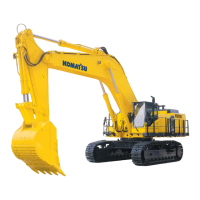
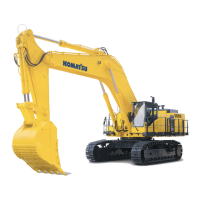
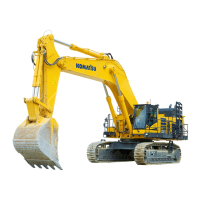




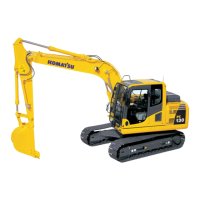
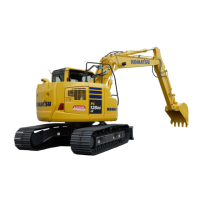

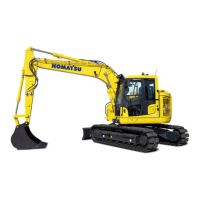
